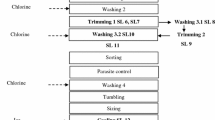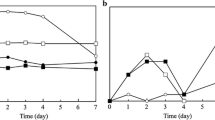Abstract
This study aimed to evaluate a method for effectively reducing Vibrio vulnificus contamination in fish based on the type of washing water and method. Texture profiles and sensory evaluations were performed to determine the effect of the developed method on the quality and preference of the samples. The selected fish sample was Konosirus punctatus, which is mainly consumed in Asian countries. Various factors that could affect the survival rate of V. vulnificus were reviewed, including water type, temperature, exposure time, organic acids, pH, and washing methods. As a result, immersion and washing with filtered water with pH adjusted to 4.0 using acetic acid showed a high bactericidal effect of 2.5 log MPN/100 g. Furthermore, this method showed no statistically significant effect on the texture and sensory characteristics of fish. The results of the present study suggest a simple and effective method for preventing V. vulnificus infection in raw fish.




Similar content being viewed by others
References
Ali A, Parisi A, Conversano M, Iannacci A, D’Emilio F, Mercurio V, Normanno G. Food-borne bacteria associated with seafoods: a brief review. Journal of Food Quality and Hazards Control. 7: 4–10 (2020)
Bang W, Drake MA. Acid adaptation of Vibrio vulnificus and subsequent impact on stress tolerance. Food Microbiology. 22: 301–309 (2005)
Ben Braïek O, Smaoui S. Chemistry, safety, and challenges of the use of organic acids and their derivative salts in meat preservation. Journal of Food Quality. 2021: 1–20 (2021)
Bhat P, Bhaskar M, Sistla S, Kadhiravan T. Fatal case of necrotising fasciitis due to Vibrio vulnificus in a patient with alcoholic liver disease and diabetes mellitus. BMJ Case Reports. 12: bcr-2018–227851 (2019)
Campbell VM, Chouljenko A, Hall SG. Depuration of live oysters to reduce Vibrio parahaemolyticus and Vibrio vulnificus: a review of ecology and processing parameters. Comprehensive Reviews in Food Science and Food Safety. 21: 3480–3506 (2022)
Castrica M, Pavlovic R, Balzaretti CM, Curone G, Brecchia G, Copelotti E, Panseri S, Pessina D, Arnoldi C, Chiesa LM. Effect of high-pressure processing on physico-chemical, microbiological and sensory traits in fresh fish fillets (Salmo salar and Pleuronectes platessa). Foods. 10: 1775 (2021)
DaSilva L, Parveen S, DePaola A, Bowers J, Brohawn K, Tamplin ML. Development and validation of a predictive model for the growth of Vibrio vulnificus in postharvest shellstock oysters. Applied and Environmental Microbiology. 78: 1675–1681 (2012)
Gu Z, Liu S, Duan Z, Kang R, Zhao M, Xia G, Shen X. Effect of citric acid on physicochemical properties and protein structure of low‐salt restructured tilapia (Oreochromis mossambicus) meat products. Journal of the Science of Food and Agriculture. 101: 1636–1645 (2021)
Hernández KL, Sedas VP, Dehaibes SR, Valencia VS, Mozo IR, Herrera DM, Primo AF, Serrano RU. Improved microbial safety of direct ozone-depurated shellstock Eastern oysters (Crassostrea virginica) by superchilled storage. Frontiers in Microbiology. 9: 2802 (2018)
Houicher A, Bensid A, Regenstein JM, Özogul F. Control of biogenic amine production and bacterial growth in fish and seafood products using phytochemicals as biopreservatives: a review. Food Bioscience. 39: 100807 (2021)
Jang YM, Park SK, Jeong HJ, Lee JW, Yoon Y, Park KS, Shin IS, Kim YM. Quantitative cell count of Vibrio vulnificus cells based on MPN-PCR method. Journal of Food Hygiene and Safety. 33: 412–415 (2018)
Jeong H, Park SK, Jo DM, Khan F, Yu D, Lee JH, Kang MG, Lee D, Sim YA, Kim YM. Effectiveness of depuration of Pacific Oyster (Crassostrea gigas): removal of bioaccumulated Vibrio vulnificus by UV-treatment. Food Science and Biotechnology. 30: 765–771 (2021)
Jo DM, Park SK, Khan F, Kang MG, Lee JH, Kim YM. An approach to extend the shelf life of ribbonfish fillet using lactic acid bacteria cell-free culture supernatant. Food Control. 123: 107731 (2021)
Kang S-J, Jung S-I, Peck KR. Historical and clinical perspective of Vibrio vulnificus infections in Korea. Journal of Infection and Chemotherapy. 52: 245 (2020)
Kim HJ, Eo JH, Kim SJ, Eun JB. Physicochemical changes in fermented skate (Raja kenojei) treated with organic acids during storage. Korean Journal of Food Science and Technology. 42: 438–444 (2010)
Kim HY, Choi JK, Shin IS. Bactericidal effects of hypochlorous acid water against Vibrio parahaemolyticus contaminated on raw fish and shellfish. Korean Journal of Food Science and Technology. 47: 719–724 (2015)
Kim HY, Hwang SH, Lee JH. Effect of fermented vinegar on the reduction in trimethylamine in konjac glucomannan gel. Applied Biological Chemistry. 60: 281–285 (2017)
Klinmalai P, Fong-In S, Phongthai S, Klunklin W. Improving the quality of frozen fillets of semi-dried Gourami Fish (Trichogaster pectoralis) by using sorbitol and citric acid. Foods. 10: 2763 (2021)
Ko JM, Oh SW, Hong JH. Sensory drivers of sliced raw fish in Korea: case study on flounder (Paralichthys olivaceus) and rockfish (Sebastes schlegeli). Journal of the Korean Society of Food Science and Nutrition. 45: 1192–1201 (2016)
Koo J, DePAOLA ANGELO, Marshall DL. Impact of acid on survival of Vibrio vulnificus and Vibrio vulnificus phage. Journal of Food Protection. 63: 1049–1052 (2000)
Kovanda L, Zhang W, Wei X, Luo J, Wu X, Atwill ER, Vaessen S, Li X, Liu Y. In vitro antimicrobial activities of organic acids and their derivatives on several species of Gram-negative and Gram-positive bacteria. Molecules. 24: 3770 (2019)
Liang J-H, Liang W-H, Deng Y-Q, Fu Z-G, Deng J-L, Chen Y-H. Vibrio vulnificus infection attributed to bee sting: a case report. Emerging Microbes & Infections. 10: 1890–1895 (2021)
McGough MD, Pruente VL, Walton WC, Jones JL. Effects of farm location on Vibrio parahaemolyticus and Vibrio vulnificus levels in oysters after desiccation and resubmersion in the northern Gulf of Mexico. Journal of Food Protection. 84: 2185–2194 (2021)
Monirul I, Yang F, Niaz M, Qixing J, Wenshui X. Effectiveness of combined acetic acid and ascorbic acid spray on fresh silver carp (Hypophthalmichthys molitrix) fish to increase shelf-life at refrigerated temperature. Current Research in Nutrition and Food Science Journal. 7: 415–426 (2019)
Palamae S, Temdee W, Buatong J, Zhang B, Hong H, Benjakul S. Enhancement of safety and quality of ready-to-cook Asian green mussel using acidic electrolyzed water depuration in combination with sous vide cooking. Innovative Food Science and Emerging Technologies. 87: 103391 (2023)
Panicker G, Call DR, Krug MJ, Bej AK. Detection of pathogenic Vibrio spp. in shellfish by using multiplex PCR and DNA microarrays. Applied and Environmental Microbiology. 70: 7436–7444 (2004)
Park SK, Jo DM, Yu D, Khan F, Lee YB, Kim YM. Reduction of trimethylamine off-odor by lactic acid bacteria isolated from Korean traditional fermented food and their in-situ application. Journal of Microbiology and Biotechnology. 30: 1510–1515 (2020)
Park SY, Chung M-S, Ha S-D. Combined effect of sodium hypochlorite and gamma-irradiation for the control of Vibrio vulnificus in fresh oyster and clam. LWT 91: 568–572 (2018)
Pearlin BV, Muthuvel S, Govidasamy P, Villavan M, Alagawany M, Ragab Farag M, Dhama K, Gopi M. Role of acidifiers in livestock nutrition and health: a review. Journal of Animal Physiology and Animal Nutrition. 104: 58–569 (2020)
Rathod NB, Ranveer RC, Benjakul S, Kim SK, Pagarkar AU, Patange S, Ozogul F. Recent developments of natural antimicrobials and antioxidants on fish and fishery food products. Comprehensive Reviews in Food Science and Food Safety. 20: 4182–4210 (2021)
Roy PK, Mizan MFR, Hossain MI, Han N, Nahar S, Ashrafudoulla M, Toushik SH, Shim W-B, Kim Y-M, Ha S-D. Elimination of Vibrio parahaemolyticus biofilms on crab and shrimp surfaces using ultraviolet C irradiation coupled with sodium hypochlorite and slightly acidic electrolyzed water. Food Control. 128: 108179 (2021)
Sampaio A, Silva V, Poeta P, Aonofriesei F. Vibrio spp.: life strategies, ecology, and risks in a changing environment. Diversity. 14: 97 (2022)
Sheikh H, Najiah M, Fadhlina A, Laith A, Nor M, Jalal K, Kasan NA. Temperature upshift mostly but not always enhances the growth of vibrio species: a systematic review. Frontiers in Marine Science. 9: 1–17 (2022)
Sun J, Mausz MA, Chen Y, Giovannoni SJ. Microbial trimethylamine metabolism in marine environments. Environmental Microbiology. 21: 513–520 (2019)
Telli AE, Doğruer Y. Discrimination of viable and dead Vibrio parahaemolyticus subjected to low temperatures using propidium monoazide–quantitative loop mediated isothermal amplification (PMA-qLAMP) and PMA-qPCR. Microbial Pathogenesis. 132: 109–116 (2019)
US Food and Drug Administration (US FDA) (2019). CFR-Code of Federal Regulations Title 21. https://www.accessdata.fda.gov/scripts/cdrh/cfdocs/cfcfr/CFRSearch.cfm. Accessed Apr. 2019.
Vu T, Alter T, Braun P, Dittrich A, Huehn S. Inactivation of Vibrio sp. in pure cultures and mussel homogenates using high hydrostatic pressure. Letters in Applied Microbiology. 67: 220–225 (2018)
Wang HY, Lee GH. Rapid identification of Vibrio vulnificus in seawater by real-time quantitative TaqMan PCR. Journal of Microbiology. 41: 320–326 (2003)
Zhao X, Chen L, Wongmaneepratip W, He Y, Zhao L, Yang H. Effect of vacuum impregnated fish gelatin and grape seed extract on moisture state, microbiota composition, and quality of chilled seabass fillets. Food Chemistry. 354: 129581 (2021)
Acknowledgements
This research was supported by the Korea Institute of Marine Science & Technology Promotion (KIMST) and funded by the Ministry of Oceans and Fisheries (20210695 and 20200377). We would like to thank Editage (www.editage.co.kr) for English language editing.
Author information
Authors and Affiliations
Corresponding author
Ethics declarations
Conflict of interest
All authors declare that they have no conflict of interest.
Additional information
Publisher's Note
Springer Nature remains neutral with regard to jurisdictional claims in published maps and institutional affiliations.
Rights and permissions
Springer Nature or its licensor (e.g. a society or other partner) holds exclusive rights to this article under a publishing agreement with the author(s) or other rightsholder(s); author self-archiving of the accepted manuscript version of this article is solely governed by the terms of such publishing agreement and applicable law.
About this article
Cite this article
Park, SK., Lee, D., Jo, DM. et al. Bactericidal effect of water-washing methods on Vibrio vulnificus contaminated in a raw fish Konosirus punctatus: water type, temperature, and pH. Food Sci Biotechnol 33, 1495–1504 (2024). https://doi.org/10.1007/s10068-023-01421-y
Received:
Revised:
Accepted:
Published:
Issue Date:
DOI: https://doi.org/10.1007/s10068-023-01421-y




